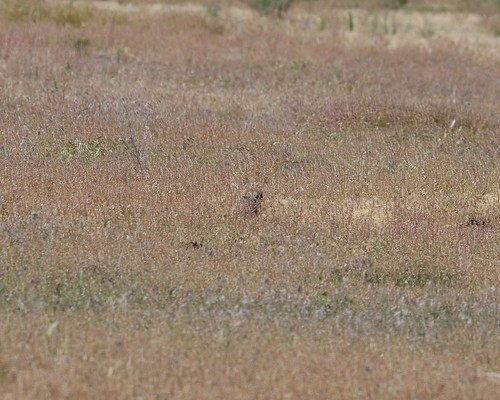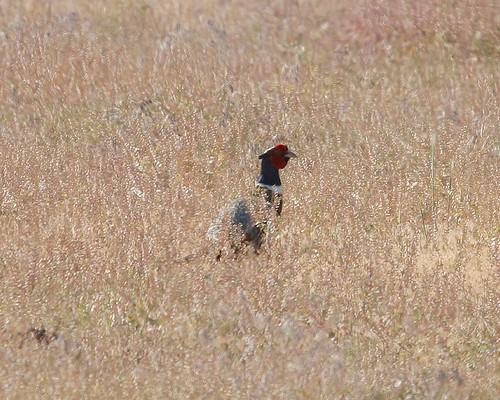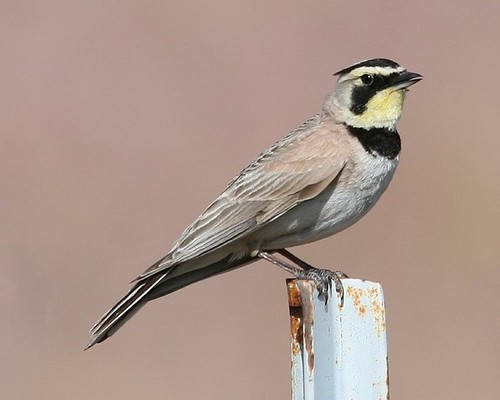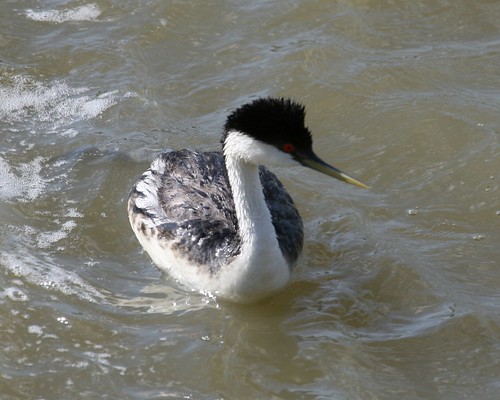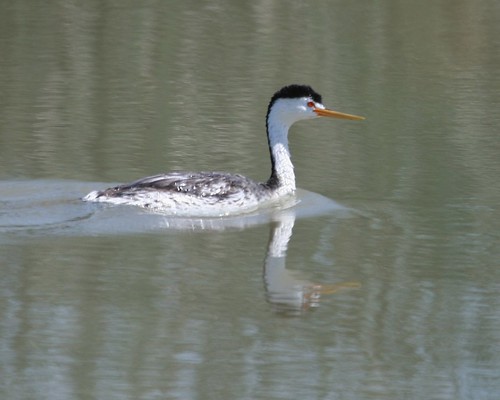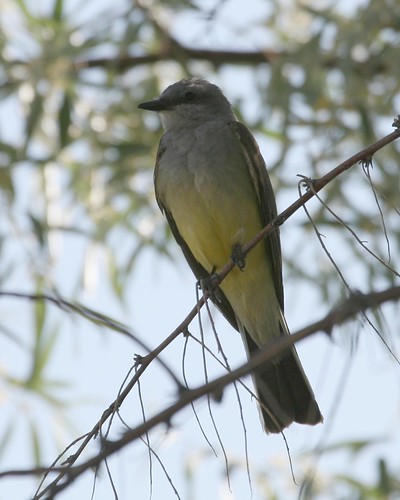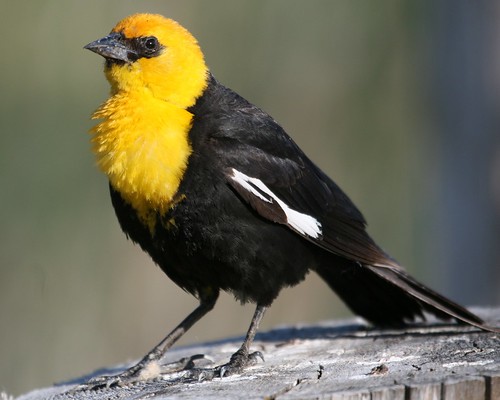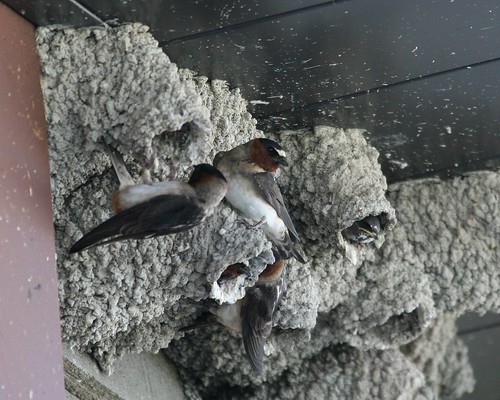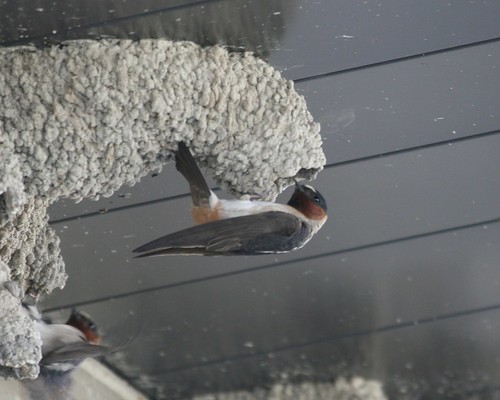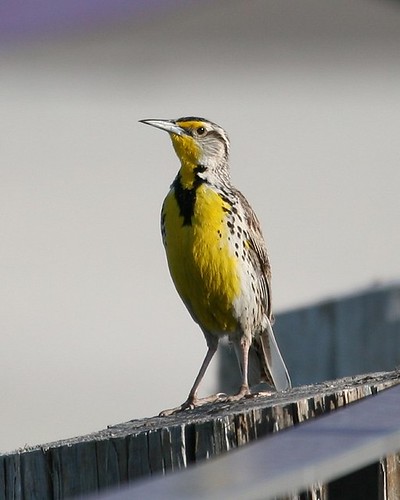The last bird I will share from my visit to Bear River Migratory Bird Refuge (BRMBR) is Black-necked Stilt. Once I got into the actual refuge, Stilts were fairly common. I even saw several nests with Stilts sitting on them. There were not, however, any Stilt babies just yet (too bad...that would have been fun to photograph).
Ring-necked Pheasant
The drive to Bear River Migratory Bird Refuge on that gravel road gave me an opportunity for another life bird: Ring-necked Pheasant. The "game" of getting a photograph of one, however, was a little more challenging.
I would drive along the road at a fairly slow speed because I was gawking out the windows looking for birds (luckily there was hardly any other traffic on the road). At one point something caught my eye directly to my left. When I looked over, I immediately recognized the pheasant, and hit the brakes. The pheasant was actually two pheasants (one male and one female) and they wanted nothing to do with me and my car. So as I fumbled about for my camera, they took off running through the field.
When running, they would extend their head forward, which would make them appear lower and longer, and shorter than the vegetation in the field. I could follow their progress through the field, but only because I saw them at the start and followed them with my eyes. Had they already gone into motion before my car got near, I doubt I would have ever seen them. Occasionally one would stop and poke its head up out of the grass, like a periscope on a submarine, to survey the situation.
I saw several more pheasants on this drive. In one case, after I had finished admiring a grebe and resumed the drive, I flushed two males. They immediately fled deeper into the field, gone in a second. It was only then that I realized that, while I was staring at the grebe (with car ignition turned off and windows all down), I was hearing the creaky wheezy song of those two pheasants just a short distance away.
Here are two photos from my first pheasant encounter. The first shows one (the female, I think) as it scoots away in the grass. The second shows the male poking his head up out of the grass in order to assess the situation.
I would drive along the road at a fairly slow speed because I was gawking out the windows looking for birds (luckily there was hardly any other traffic on the road). At one point something caught my eye directly to my left. When I looked over, I immediately recognized the pheasant, and hit the brakes. The pheasant was actually two pheasants (one male and one female) and they wanted nothing to do with me and my car. So as I fumbled about for my camera, they took off running through the field.
When running, they would extend their head forward, which would make them appear lower and longer, and shorter than the vegetation in the field. I could follow their progress through the field, but only because I saw them at the start and followed them with my eyes. Had they already gone into motion before my car got near, I doubt I would have ever seen them. Occasionally one would stop and poke its head up out of the grass, like a periscope on a submarine, to survey the situation.
I saw several more pheasants on this drive. In one case, after I had finished admiring a grebe and resumed the drive, I flushed two males. They immediately fled deeper into the field, gone in a second. It was only then that I realized that, while I was staring at the grebe (with car ignition turned off and windows all down), I was hearing the creaky wheezy song of those two pheasants just a short distance away.
Here are two photos from my first pheasant encounter. The first shows one (the female, I think) as it scoots away in the grass. The second shows the male poking his head up out of the grass in order to assess the situation.
Horned Lark
I had never seen a Horned Lark before visiting Utah last month. Since I really have not taken any time to analyze my life list to see what I am missing within the ABA Area, there are still plenty of "easy" birds for me to see that are lifers. The Horned Lark was an example of that. I should be able to see one in my home state, but I haven't. Instead, I flew to Utah and saw one there :-)
When I decided to visit the Bear River National Migratory Bird Refuge, I had a small sense of the birds I might see, but not the complete picture. I went in just figuring I would see what I would see, and then later when I submitted my sightings to eBird I would notice which were lifers for me. For a few of the birds, however, I knew I had a lifer when I saw them. Again, the Horned Lark was an example of that.
Driving from the refuge's visitor center into the actual refuge takes you along a mostly gravel country road for nearly ten miles. Along the way, I blithely ignored the sticker in my rental car, conveniently hidden by the flipped down driver-side visor, that read something along the lines of "Thou shalt not drive this vehicle on unpaved roads, under penalty of embarrassment and significant expense!" Bah! I was not going to let some silly rule keep me from exploring that refuge. This quaint (and somewhat bumpy) road took me past lots of uncultivated fields with simple wire fences around them. My picture of an Eastern Kingbird a few posts back was on such a fence. The Horned Lark pictured below is on a fence post, and is just one of the many Horned Larks I saw near the road. They were impossible to miss, numerous, and immediately recognizable.
When I decided to visit the Bear River National Migratory Bird Refuge, I had a small sense of the birds I might see, but not the complete picture. I went in just figuring I would see what I would see, and then later when I submitted my sightings to eBird I would notice which were lifers for me. For a few of the birds, however, I knew I had a lifer when I saw them. Again, the Horned Lark was an example of that.
Driving from the refuge's visitor center into the actual refuge takes you along a mostly gravel country road for nearly ten miles. Along the way, I blithely ignored the sticker in my rental car, conveniently hidden by the flipped down driver-side visor, that read something along the lines of "Thou shalt not drive this vehicle on unpaved roads, under penalty of embarrassment and significant expense!" Bah! I was not going to let some silly rule keep me from exploring that refuge. This quaint (and somewhat bumpy) road took me past lots of uncultivated fields with simple wire fences around them. My picture of an Eastern Kingbird a few posts back was on such a fence. The Horned Lark pictured below is on a fence post, and is just one of the many Horned Larks I saw near the road. They were impossible to miss, numerous, and immediately recognizable.
Western vs. Clark's Grebe
My last post on something other than this blog was about the Kingbirds I saw in Bear River Migratory Bird Refuge back in June. This post continues the theme of comparing two species that I photographed in that location. This time it is Grebes: Western and Clark's.
These two Grebes are look-alikes. Well...mostly. As an easterner (within the United States :-), I was at first a little bamboozled by these two species. But just a tad of research and studying clarified the field mark that needed my attention: on the bird's face, where was the line between the black and the white? If that line was above the bird's eye, then call it a Clark's. Otherwise, call it a Western. Apparently you can also use bill color to help make the identification (according to my Peterson, a Western has a greenish yellow bill with a dark ridge, and a Clark's has a orange-yellow bill), but that field mark was a tad too subtle for me, especially under different light conditions and (usually) over a long distance.
Here are my two photos. The first is a Western and the second is a Clark's. The location of the eye relative to the line between the white and black feathers is very easy to see. Even better, I can see the difference in bill color in these photographs as well.
These two Grebes are look-alikes. Well...mostly. As an easterner (within the United States :-), I was at first a little bamboozled by these two species. But just a tad of research and studying clarified the field mark that needed my attention: on the bird's face, where was the line between the black and the white? If that line was above the bird's eye, then call it a Clark's. Otherwise, call it a Western. Apparently you can also use bill color to help make the identification (according to my Peterson, a Western has a greenish yellow bill with a dark ridge, and a Clark's has a orange-yellow bill), but that field mark was a tad too subtle for me, especially under different light conditions and (usually) over a long distance.
Here are my two photos. The first is a Western and the second is a Clark's. The location of the eye relative to the line between the white and black feathers is very easy to see. Even better, I can see the difference in bill color in these photographs as well.
And We're Back!
It has been just over two weeks since my last blog post. That is quite a while, even for my tepid blogginess. A perfect storm of sorts came together and resulted in the need for a break from blogging: my recent return from vacation, the corresponding resumption of the normal daily grind at work, and the effort to complete the transition from Phanfare to Flickr. Combine all three of those, simmer them in the summer heat, and voilà! No blogging for two weeks!
Credit this guy for reminding me that while no one else may be complaining, he was within days of breaking into my house to steal my computer...since I was obviously not using it. Or, I could start blogging again. My choice.
Why I didn't use the same tactic against him somewhere between January and July of this year is beyond me. I hear he has a nice computer, no rakes, and an easily distracted attack beagle. Sorry...inside joke.
Let the blogging resume :-)
Credit this guy for reminding me that while no one else may be complaining, he was within days of breaking into my house to steal my computer...since I was obviously not using it. Or, I could start blogging again. My choice.
Why I didn't use the same tactic against him somewhere between January and July of this year is beyond me. I hear he has a nice computer, no rakes, and an easily distracted attack beagle. Sorry...inside joke.
Let the blogging resume :-)
Whew!
Way back in December of last year I announced that I was moving all of my photos from Phanfare to Flickr. Getting all of my photographs uploaded to Flickr was fairly easy, since it was very automated (e.g. dump a bunch of photos into an uploader tool, click go, come back in a couple hours, rinse, repeat). The real challenge was this blog. All of the photos in this blog were pulled in from links to Phanfare, so I had to manually update each and every one of those links to point to the same picture in Flickr. Even better, if the photo that appeared in my blog was a cropped image, I had to find the original and re-crop it using tools within Flickr. I "fixed" over 300 blog posts, many with multiple pictures within them, most of them cropped from the original. That long process started in January and, as of today, has finally come to an end.
Whew!
I will be sending the folks at Phanfare my official departure email either today or tomorrow, which will close my account with them, and, I think, cause them to mail me a DVD of all the photos I had uploaded to them. I should add that I hold no ill will towards Phanfare. They are a fine company. Their focus, however, shifted to a model of photo sharing that was not aligned with what I wanted from a photo hosting web site. That reason, and not poor customer service or inconsistent website uptime, was the reason I moved to Flickr.
Whew!
I will be sending the folks at Phanfare my official departure email either today or tomorrow, which will close my account with them, and, I think, cause them to mail me a DVD of all the photos I had uploaded to them. I should add that I hold no ill will towards Phanfare. They are a fine company. Their focus, however, shifted to a model of photo sharing that was not aligned with what I wanted from a photo hosting web site. That reason, and not poor customer service or inconsistent website uptime, was the reason I moved to Flickr.
Eastern vs. Western Kingbird
After I left the Bear River Migratory Bird Refuge visitor center, it was a drive of several miles before I got to the actual refuge. The drive was along a quiet country road, and I stopped several times to bird the fields along this road. One of the species I saw several times was Western Kingbird. Since I had not done very much research on the birds I might see, however, I was a bit surprised to also see just as many Eastern Kingbirds.
There are several "eastern/western" species pairs that come to mind as I write this: Meadowlark, Wood-Pewee and Kingbird. For the Meadowlark and Wood-Pewee species pairs, I think the eastern variety looks very similar to the western variety, so understanding song, habitat, behavior or range differences helps me understand which one I am observing. But the differences between an Eastern Kingbird and a Western Kingbird are much more obvious to me. My challenge was not understanding that I had something other than Eastern Kingbird, but understanding which of the other U.S. Kingbird species I was observing (Tropical, Couch's, Cassin's, Thick-billed, or even Gray).
I am used to the Eastern Kingbird: white underparts; black or dark gray head, back, wings and tail; white edge at the end of the tail; and a song that sounds like electricity buzzing. When I saw one of them on my drive to the refuge, I knew it immediately. I did not realize that I had it so easy, however, when dealing with Eastern Kingbirds back home. Of all of the Kingbird species that occur in the U.S., the Eastern's appearance is fairly unique. I guess that is not entirely true, since the Gray Kingbird is moderately close in appearance to an Eastern. But since you will probably need to be in south Florida in order to see a Gray, I quickly ruled it out as an option.
So that left five more Kingbird choices, and to my inexperienced eyes they look fairly similar to each other. All but one of them, however, could be ruled out for much the same reason as Gray: it would very unlikely to see them in Northern Utah. Even better, the bird I was observing had white edges down the sides of its tail. So, being in Northern Utah, and looking at a Kingbird with white edges down the sides of his tail, told me that this was a Western Kingbird and not one of the others.
Here are my photos. The first is a Western Kingbird. He was perched under the shady canopy of a tree. The second is an Eastern Kingbird. He was perched on a wire fence next to the road.
There are several "eastern/western" species pairs that come to mind as I write this: Meadowlark, Wood-Pewee and Kingbird. For the Meadowlark and Wood-Pewee species pairs, I think the eastern variety looks very similar to the western variety, so understanding song, habitat, behavior or range differences helps me understand which one I am observing. But the differences between an Eastern Kingbird and a Western Kingbird are much more obvious to me. My challenge was not understanding that I had something other than Eastern Kingbird, but understanding which of the other U.S. Kingbird species I was observing (Tropical, Couch's, Cassin's, Thick-billed, or even Gray).
I am used to the Eastern Kingbird: white underparts; black or dark gray head, back, wings and tail; white edge at the end of the tail; and a song that sounds like electricity buzzing. When I saw one of them on my drive to the refuge, I knew it immediately. I did not realize that I had it so easy, however, when dealing with Eastern Kingbirds back home. Of all of the Kingbird species that occur in the U.S., the Eastern's appearance is fairly unique. I guess that is not entirely true, since the Gray Kingbird is moderately close in appearance to an Eastern. But since you will probably need to be in south Florida in order to see a Gray, I quickly ruled it out as an option.
So that left five more Kingbird choices, and to my inexperienced eyes they look fairly similar to each other. All but one of them, however, could be ruled out for much the same reason as Gray: it would very unlikely to see them in Northern Utah. Even better, the bird I was observing had white edges down the sides of its tail. So, being in Northern Utah, and looking at a Kingbird with white edges down the sides of his tail, told me that this was a Western Kingbird and not one of the others.
Here are my photos. The first is a Western Kingbird. He was perched under the shady canopy of a tree. The second is an Eastern Kingbird. He was perched on a wire fence next to the road.
Yellow-headed Blackbird
One of my favorite birds from the 2008 ABA Convention was Yellow-headed Blackbird. Ironically, this was not a life bird for me. I managed to get a fleeting glimpse of one during the 2005 ABA Convention while visiting a place called Arivaca Cienega. During this trip out west, however, I got lots of very long looks at Yellow-headed Blackbird, including the one who posed so nicely for my photograph.
If you compare the setting for this Yellow-headed Blackbird photo to that of the Western Meadowlark photo, they might look nearly the same. Both birds are standing on top of a wooden post. The posts are different posts, but they were both along the walkway outside the Bear River Migratory Bird Refuge visitor center. This Yellow-headed Blackbird was making the rounds between three or four different roosts, stopping to preen and sing on each. The wooden post was one of his stops, so I positioned myself where the light was favorable and waited for him to return.
If you compare the setting for this Yellow-headed Blackbird photo to that of the Western Meadowlark photo, they might look nearly the same. Both birds are standing on top of a wooden post. The posts are different posts, but they were both along the walkway outside the Bear River Migratory Bird Refuge visitor center. This Yellow-headed Blackbird was making the rounds between three or four different roosts, stopping to preen and sing on each. The wooden post was one of his stops, so I positioned myself where the light was favorable and waited for him to return.
Cliff Swallow
There are lots of swallows in Utah. On the various trips I took last week I saw Tree, Cliff, Barn, Violet-green and Northern Rough-winged. I saw my fair share of their nests as well. Swallows seem to have adapted very nicely to the structures that humankind has created, so you will frequently find their nests under bridges and on the sides of buildings.
Within the Bear River Migratory Bird Refuge, the swallow populations were immense. I saw very large colonies of both Cliff Swallows and Barn Swallows. At the refuge visitor center, for example, you can watch Cliff Swallows tend to their mud nests and the chicks within just by parking your car and walking a few yards to the front door. Stop right outside the front door and look up at the building to your right. They are impossible to miss.
Within the Bear River Migratory Bird Refuge, the swallow populations were immense. I saw very large colonies of both Cliff Swallows and Barn Swallows. At the refuge visitor center, for example, you can watch Cliff Swallows tend to their mud nests and the chicks within just by parking your car and walking a few yards to the front door. Stop right outside the front door and look up at the building to your right. They are impossible to miss.
Western Meadowlark
Monday of last week was the first day of the 2008 ABA Convention, which meant registration and a dinner. No guided field trips would occur until Tuesday. Since I was already there, and registration takes all of five minutes, I took my own personal field trip to Bear River Migratory Bird Refuge. The Bear River starts in eastern Utah, flows north into Wyoming, then hangs a left into Idaho before finally flowing south back into Utah and the northern end of the Great Salt Lake. The last few miles of the river before it flows into the Great Salt Lake is where the Bear River Migratory Bird Refuge is located.
If you enjoy bird watching, and find yourself near Salt Lake City, you should visit Bear River Migratory Bird Refuge. Start at the visitor center, located right next to I-15 near Brigham City. The bird watching there alone is very nice. When you leave the visitor center and drive to the actual refuge, be patient and bird along that route. Within the refuge itself, you follow a gravel road along a wide loop and continue to bird from your car. Starting at the visitor center, I birded about five hours before hunger changed my priorities and I decided to leave the refuge before finishing that wide loop. I could have birded two or three more hours if I had brought some lunch with me.
This post (and the next few) will highlight some of the birds I found on my visit to Bear River Migratory Bird Refuge. The first is a Western Meadowlark. I saw these all day, but mostly at the visitor center and along the drive to the refuge. To me, they look almost exactly the same as an Eastern Meadowlark, but their song does sound different. This particular Western Meadowlark was at the refuge visitor center. He decided to roost on a nearby post, allowing me to get this photograph.
If you enjoy bird watching, and find yourself near Salt Lake City, you should visit Bear River Migratory Bird Refuge. Start at the visitor center, located right next to I-15 near Brigham City. The bird watching there alone is very nice. When you leave the visitor center and drive to the actual refuge, be patient and bird along that route. Within the refuge itself, you follow a gravel road along a wide loop and continue to bird from your car. Starting at the visitor center, I birded about five hours before hunger changed my priorities and I decided to leave the refuge before finishing that wide loop. I could have birded two or three more hours if I had brought some lunch with me.
This post (and the next few) will highlight some of the birds I found on my visit to Bear River Migratory Bird Refuge. The first is a Western Meadowlark. I saw these all day, but mostly at the visitor center and along the drive to the refuge. To me, they look almost exactly the same as an Eastern Meadowlark, but their song does sound different. This particular Western Meadowlark was at the refuge visitor center. He decided to roost on a nearby post, allowing me to get this photograph.
Subscribe to:
Posts (Atom)

